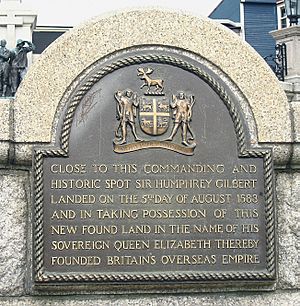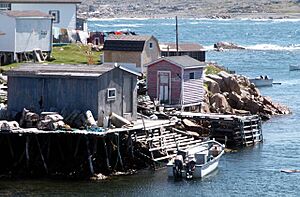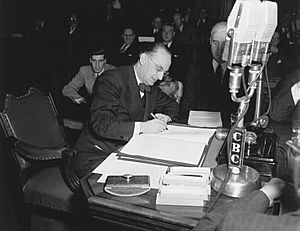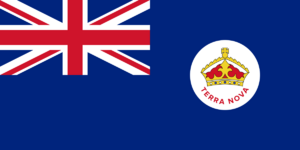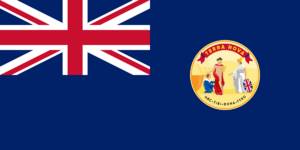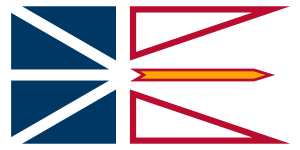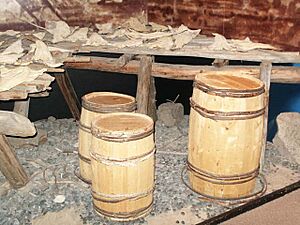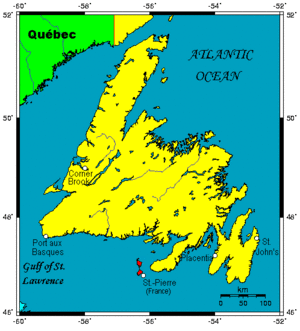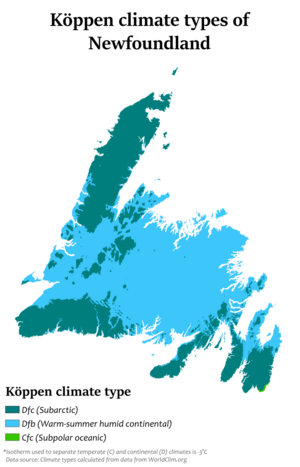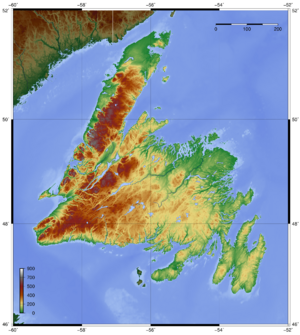Newfoundland (island) facts for kids
|
Nickname: "The Rock"
|
|
|---|---|
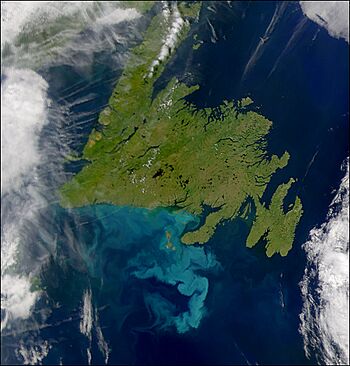
Satellite view of Newfoundland
|
|
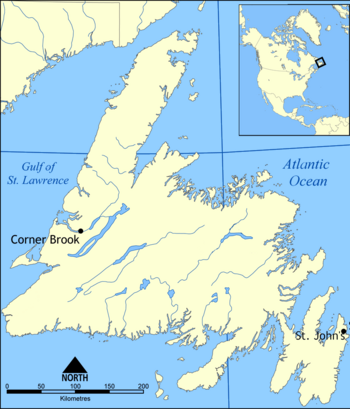
Map of Newfoundland
|
|
| Geography | |
| Location | Atlantic Ocean |
| Coordinates | 48°36′N 56°20′W / 48.600°N 56.333°W |
| Area | 108,860 km2 (42,030 sq mi) |
| Area rank | 4th largest in Canada 16th largest worldwide |
| Coastline | 9,656 km (6,000 mi) |
| Highest elevation | 814 m (2,671 ft) |
| Highest point | The Cabox |
| Administration | |
|
Canada
|
|
| Province | |
| Largest settlement | St. John's (pop. 200,600) |
| Demographics | |
| Demonym | Newfie, Newfoundlander |
| Population | 477,787 (2016) |
| Population rank | 79 |
| Pop. density | 4.39 /km2 (11.37 /sq mi) |
| Ethnic groups | English, Irish, Scottish, French, and Mi'kmaq |
| Additional information | |
| Time zone |
|
| • Summer (DST) |
|
| Longest river: Exploits River (246 km or 153 mi) |
|
Newfoundland is a large island in the Canadian province of Newfoundland and Labrador. It sits off the eastern coast of North America, near the region of Labrador.
This island makes up 29% of the province's land. However, it is home to over 90% of the province's people. About 60% of the population lives on the small southeastern Avalon peninsula. The Strait of Belle Isle separates Newfoundland from the Labrador Peninsula. The Cabot Strait separates it from Cape Breton Island. Newfoundland blocks the mouth of the Saint Lawrence River. This creates the Gulf of Saint Lawrence, the world's largest estuary. Newfoundland's closest neighbor is Saint Pierre and Miquelon, a French territory.
Newfoundland is 108,860 square kilometres (42,031 sq mi) in size. This makes it the 16th largest island in the world. It is also Canada's fourth-largest island. It is the biggest Canadian island outside the North.
The capital city, St. John's, is on the island's southeastern coast. Cape Spear, just south of St. John's, is the easternmost point of North America, not including Greenland. Smaller islands like New World, Twillingate, Fogo, and Bell Island are often considered part of Newfoundland. With these islands, the total area is 111,390 square kilometres (43,008 sq mi).
In 2006, 57% of people in Newfoundland and Labrador said they had British or Irish family roots. About 43.2% had at least one English parent. About 21.5% had at least one Irish parent. Around 7% had at least one Scottish parent. Also, 6.1% had at least one French parent. In 2006, the island's population was 479,105 people.
Contents
Exploring Newfoundland's Past
Newfoundland was home to Dorset culture people for a long time. Later, the Beothuk people lived there. They spoke the Beothuk language, which is now extinct.
Early Visitors and Settlements
Some people believe the Icelandic explorer Leif Erikson visited Newfoundland in the 11th century. He might have used it as a stop on his way to "Vinland". The first confirmed visit was by the Norse. They built a temporary base at L'Anse aux Meadows. This Norse settlement is near the northern tip of Newfoundland. It is about 1000 years old. This site is the only clear proof of contact between Europe and North America before Christopher Columbus.
After the Norse, Portuguese and French fishermen visited the island. The Venetian navigator John Cabot (Giovanni Caboto) might have visited in 1497. He was working for King Henry VII of England. In 1501, Portuguese explorers Gaspar Corte-Real and his brother Miguel Corte-Real mapped part of Newfoundland's coast. They were trying to find the Northwest Passage.
On August 5, 1583, Humphrey Gilbert claimed Newfoundland for England. This made it England's first colony overseas. It was an early step toward the British Empire. Newfoundland is known as Britain's oldest colony.
Settlers on the island developed different ways of speaking. These included Newfoundland English and Newfoundland French. In the 1800s, a type of Irish called Newfoundland Irish was also spoken. Scottish Gaelic was also spoken, especially in the Codroy Valley area. This was mainly by settlers from Cape Breton Island. In Scottish Gaelic, Newfoundland was called Eilean a' Trosg, meaning 'Island of the Cod'. The Irish name Talamh an Éisc means 'Land of the Fish'.
Who Lived Here First?
The first people in Newfoundland were the Paleo-Eskimo. We know little about them, mostly from archeological finds. Later, the Dorset culture settled there about 4,000 years ago. They came from ancient people who crossed from Siberia over the Bering land bridge. The Dorset people either died out or left the island before the Norse arrived.
After the Dorset, the Beothuk people settled in Newfoundland. They moved from Labrador. There is no proof the Beothuk lived on the island before the Norse. Experts think the Beothuk are related to the Innu people of Labrador. The Beothuk tribe was later said to be "extinct." However, some people with Beothuk family members have been found. The name Beothuk meant 'people' in their language. This language is thought to be part of the Algonquian language family.
The Beothuk tribe is now usually considered extinct. But their culture is kept in museums and historical records. Shanawdithit, often called the last full-blood Beothuk, died in St. John's in 1829 from tuberculosis. However, Santu Toney, born around 1835, was part Mi'kmaq and part Beothuk. She said her father was Beothuk and her mother Mi'kmaq, both from Newfoundland. This means some Beothuk lived past 1829. The Beothuk might have mixed with Innu in Labrador and Mi'kmaq in Newfoundland.
Europeans arrived starting in 1497 with John Cabot. They met the Beothuk. Estimates of the Beothuk population at that time are around 700. Later, both the English and French settled the island. The Mi'kmaq, an Algonquian-speaking group from eastern Canada, also came. As Europeans and Mi'kmaq settled year-round, the Beothuk had less land to find food. By the early 1800s, few Beothuk were left. Most died from infectious diseases brought by Europeans. They had no immunity to these illnesses. They also died from starvation. Government efforts to help the Beothuk came too late. The Beothuk did not have friendly relations with foreigners. The Mi'kmaq, however, traded with Europeans and settled in Newfoundland.
European Arrivals and Settlements
Newfoundland has the only confirmed Norse settlement in North America. An archaeological site was found in 1960 at L'Anse aux Meadows. Norwegian explorer Helge Ingstad and his wife, archaeologist Anne Stine Ingstad, found it. Studies showed the settlement dates to about the year 1000. It has the earliest known European buildings in North America. In 2021, scientists used tree rings to confirm Vikings were there in 1021.
This site is a World Heritage Site by UNESCO. It is thought to be the Vinland settlement of explorer Leif Erikson. Before and after the Norse left, indigenous people lived on the island.
Cabot's Journey
About 500 years later, in 1497, the Italian navigator John Cabot was the first European since the Norse to land in Newfoundland. He worked for King Henry VII of England. His landing spot is unknown. Many believe it was Cape Bonavista on the east coast. Another idea is Cape Bauld, at the tip of the Great Northern Peninsula. A document from Spain says Cabot landed 1,800 miles or 2,900 kilometres west of Dursey Head, Ireland. This would put him near Cape Bauld. The document also mentions an island Cabot sailed past before landing. This fits with the Cape Bauld idea, as Belle Isle is nearby.
Other European Explorers
After Cabot, many European fishermen visited Newfoundland. These included Portuguese, Spanish, Basque, French, and English groups. In 1501, Portuguese explorers Gaspar Corte-Real and his brother Miguel Corte-Real mapped part of the coast. They failed to find the Northwest Passage. Later in the 1600s, Irish fishermen came. They found so many fish that they named the island Talamh an Éisc, meaning 'Land of the Fish'.
Establishing Colonies
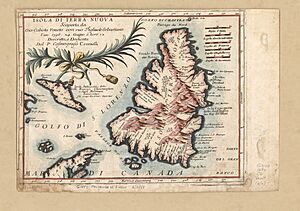
In 1583, Sir Humphrey Gilbert officially claimed Newfoundland for England. He found many English, French, and Portuguese ships in St. John's. But there were no permanent European residents. Gilbert was lost at sea on his way back. Plans for settlement were put on hold.
In July 1596, a Scottish ship called the "William" sailed from Aberdeen to "new fund land" (Newfoundland). It returned in 1600.
On July 5, 1610, John Guy sailed from Bristol, England. He had 39 other settlers with him, heading for Cuper's Cove. These early attempts to settle permanently did not make money for English investors. But some settlers stayed. They formed the first modern European population on the island. By 1620, fishermen from England's West Country controlled the east coast of Newfoundland. French fishermen controlled the island's south coast and Northern Peninsula.
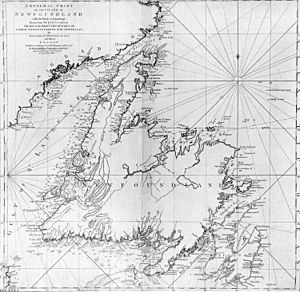
After 1713, with the Treaty of Utrecht, the French gave control of the island's south and north shores to the British. They only kept the nearby islands of St. Pierre and Miquelon. These islands are in the fish-rich Grand Banks. The British government did not encourage people to live in Newfoundland year-round. Thomas Nash was an Irish Catholic fisherman who settled permanently. He started the fishing town of Branch. He and his cousin, Father Patrick Power, helped spread Catholicism in Newfoundland. This led to many Irish Catholic immigrants coming to Newfoundland in the early 1700s.
By the late 1700s, more people settled permanently. This peaked in the early 1800s.
The French name for the island is Terre-Neuve. The name Newfoundland is one of the oldest European place names in Canada. It has been used continuously since a 1502 letter. A poem from 1628 praised Newfoundland:
A Skeltonicall continued ryme, in praise of my New-found-Land
- Although in cloaths, company, buildings faire
- With England, New-found-land cannot compare:
- Did some know what contentment I found there,
- Alwayes enough, most times somewhat to spare,
- With little paines, lesse toyle, and lesser care,
- Exempt from taxings, ill newes, Lawing, feare,
- If cleane, and warme, no matter what you weare,
- Healthy, and wealthy, if men careful are,
- With much-much more, then I will now declare,
- (I say) if some wise men knew what this were
- (I doe beleeue) they'd live no other where.
-
- From 'The First Booke of Qvodlibets'
- Composed and done at Harbor-Grace in
- Britaniola, anciently called Newfound-Land
- by Governor Robert Hayman – 1628.
After the 13 American colonies became the United States of America in 1783, the remaining British colonies in North America were grouped. All except the Newfoundland Colony and Bermuda joined together in 1867 to form the Dominion of Canada. Newfoundland and Bermuda kept their own ties. Newfoundland became a Dominion in 1907. It went back to being a colony in 1934. Finally, it joined Canada in 1949 as the Province of Newfoundland.
A New Way of Life
European immigrants, mostly English, Scots, Irish, and French, built a new society in Newfoundland. It was different from their home countries. It was also different from other places immigrants settled in North America. Newfoundland exported fish, so it had contact with many ports around the Atlantic. But its location and unique government kept it separate from Canada and the United States. Inside the island, most people lived in small fishing villages called outports. These were spread out along the rough coastline. Many were far from bigger towns and cut off by winter ice or bad weather.
These conditions changed the cultures of the immigrants. They created new ways of thinking and acting. Newfoundland and Labrador developed many unique customs, beliefs, stories, songs, and dialects. A special vocabulary grew. It focused on the sea ice, weather, and wildlife that people relied on for food and income.
Impact of World Wars
The First World War greatly affected Newfoundland society. Out of about 250,000 people, 5,482 men went to fight overseas. Nearly 1,500 were killed, and 2,300 were wounded. On July 1, 1916, at Beaumont-Hamel, France, 753 men of the Royal Newfoundland Regiment attacked. The next morning, only 68 men were left. Even now, when the rest of Canada celebrates its founding on July 1, many Newfoundlanders remember this day with sadness.
The Second World War also had a lasting effect. The United States set up military bases at Argentia, Gander, Stephenville, Goose Bay, and St. John's.
Newfoundland and Labrador is Canada's newest province. Newfoundland became a colony in 1825. It governed itself from 1855 to 1934. But after a money crisis, its government was stopped. It was then ruled by a Newfoundland Commission of Government. On June 22 and July 3, 1948, the people of the colony voted. About 52.3% voted to join Canada as a province. People in the capital, St. John's, and the nearby Avalon Peninsula were mostly against joining.
Joining Canada
Newfoundland joined Canada just before midnight on March 31, 1949. Joining Canada did not make Newfoundlanders feel less unique. In 2003, 72% of people said they identified first as Newfoundlanders, then as Canadians. However, few people want to separate from Canada, less than 12% in the same 2003 study.
The 1948 vote was a tough fight. Both Canada and Britain wanted Newfoundland to join Canada. Jack Pickersgill, a Canadian politician, worked with the group that wanted to join. The Catholic Church, a minority on the island, wanted Newfoundland to stay independent. Canada offered money benefits, like a "baby bonus" for each child.
The group that wanted to join Canada was led by Joseph Smallwood. He was a former radio broadcaster. He had developed socialist ideas while working for a socialist newspaper in New York City. After joining Canada, Smallwood led Newfoundland for decades as the elected premier. His policies as premier were more like liberalism than socialism.
Newfoundland's Flags
The first flag for Newfoundland might have been a green fir tree on a pink background. This was used in the early 1800s. The first official flag was the Newfoundland Blue Ensign. It was used by government ships from 1870 to 1904. In 1904, the flag was changed slightly. The crown was replaced with the Great Seal of Newfoundland. The British Parliament made the Newfoundland Red and Blue ensigns official flags for Newfoundland. The Red Ensign was used by merchant ships. The Blue Ensign was used by government ships. This was like the British tradition.
On September 26, 1907, King Edward VII declared Newfoundland an independent Dominion within the British Empire. From then until 1965, the Newfoundland Red Ensign was the flag for merchant ships. The Blue Ensign was for government ships. In 1931, the Newfoundland National Assembly made the Union Jack the official national flag. The Red and Blue Ensigns were still used for ships.
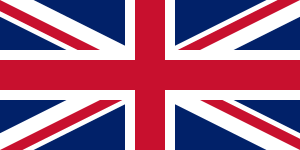
On March 31, 1949, Newfoundland became a province of Canada. But it kept the Union Jack as its "national" flag. This was confirmed in 1952. The Union Jack remained the official flag until 1980. Then, it was replaced by the current provincial flag.
Cool Places to Visit
Newfoundland has the most Dorset culture archaeological sites. The Beothuk and Mi'kmaq did not leave as much evidence.
Newfoundland was one of the first places in the New World where Europeans settled. So, it has a long history of European colonization. St. John's is the oldest city in Canada. It is also the oldest continuously settled place in English-speaking North America.
The St. John's area includes 12 smaller communities. The largest are Mount Pearl, Conception Bay South, and Paradise. The province's third-largest city is Corner Brook. It is on the Bay of Islands on the west coast. Captain James Cook named the bay in 1767 when he mapped the coast.
Newfoundland island has many provincial parks. Barachois Pond Provincial Park is one example. It also has two national parks:
- Gros Morne National Park is on the west coast. It became a UNESCO World Heritage Site in 1987. This is because of its amazing geology and beautiful scenery. It is the largest national park in Atlantic Canada at 1,805 km2 (697 sq mi). It is a popular place for tourists.
- Terra Nova National Park is on the east side. It protects the rugged land of the Bonavista Bay area. Visitors can learn about how land, sea, and people have interacted there.
- L'Anse aux Meadows is an archaeological site. It is near the northern tip of the island (Cape Norman). It is the only known Norse village site in North America outside of Greenland. It is a UNESCO World Heritage Site. It is the only widely accepted site of contact between continents before Columbus. It is linked to the Vinland colony started by Leif Ericson around 1003.
- Heart's Content, Newfoundland and Labrador is important in communication history. Cyrus West Field chose it as the end point for his Transatlantic telegraph cable. This led to the Heart's Content Cable Station.
The island offers many tourism activities. These include sea kayaking, camping, fishing, hunting, and hiking. The International Appalachian Trail (IAT) is being extended along the island's western mountains. On the east coast, the East Coast Trail runs for 220 km (140 mi) through the Avalon Peninsula. It starts near Fort Amherst in St. John's and ends in Cappahayden. Another 320 km (200 mi) of trail is being built.
The Marble Mountain Ski Resort near Corner Brook is a big draw for skiers in eastern Canada during winter.
Other important towns include:
- Gander, home to the Gander International Airport.
- Grand Falls-Windsor, a service center for the middle of the island.
- Channel-Port aux Basques, known as the "Gateway to Newfoundland." It is the closest point on the island to Nova Scotia. It also has the Marine Atlantic ferry terminal that connects the island to the rest of Canada.
- Stephenville, which used to have the Ernest Harmon Air Force Base. Now it has the Stephenville Airport.
Educational places include Memorial University of Newfoundland. Its main campus is in St. John's. There is also the Grenfell Campus in Corner Brook. The College of the North Atlantic is based in Stephenville and other towns.
Bonavista, Placentia, and Ferryland are historic places. They were sites of early European settlement or discovery. Tilting Harbour on Fogo Island is a special Heritage District. It is also a National Cultural Landscape District of Canada. This is one of only two national historic sites in Canada recognized for their Irish heritage.
There are many fun things to do in the island's cities and towns, especially during summer festivals. For nightlife, George Street in downtown St. John's is closed to traffic for 20 hours a day. The Mile One Stadium in St. John's hosts big sports and concert events.
In March, the yearly seal hunt (of the harp seal) takes place.
Major Towns and Cities
Here are the largest towns and cities by population in 2016:
- St. John's (108,860 people)
- Conception Bay South (26,199 people)
- Mount Pearl (23,120 people)
- Paradise (21,389 people)
- Corner Brook (19,806 people)
- Grand Falls-Windsor (14,171 people)
- Gander (11,688 people)
- Portugal Cove-St. Philip's (8,147 people)
- Torbay (7,899 people)
- Stephenville (6,623 people)
- Clarenville (6,291 people)
- Bay Roberts (6,012 people)
- Marystown (5,316 people)
- Deer Lake (5,249 people)
Newfoundland's Geography
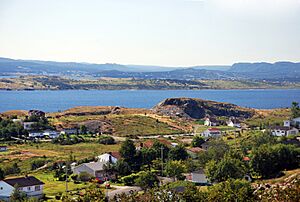
Newfoundland is shaped roughly like a triangle. Each side is about 500 kilometres[convert: unknown unit] long. Its area is 108,860 square kilometres[convert: unknown unit]. Newfoundland and its small nearby islands have a total area of 111,390 square kilometres[convert: unknown unit]. Newfoundland stretches between 46°36'N and 51°38'N latitude.
Newfoundland's Climate
Newfoundland mostly has a subarctic climate (Köppen Dfc) or a humid continental climate (Köppen Dfb). Places on the far southeast of the island have enough ocean influence to be a subpolar oceanic climate (Köppen Cfc).
Newfoundland's Geology
The Terreneuvian Epoch, which starts the Cambrian Period of geological time, is named after Terre Neuve. This is the French name for Newfoundland.
Geographical Features
- Baccalieu Island
- Barasway Bay
- Barred Bay
- Bay de Loup
- Bay Le Moine
- Cinq Cerf Bay
- Connoire Bay
- Diable Bay
- Dragon Bay
- Good Bay
- Grand Galets Bay
- Knife Bay
- La Hune Bay
- Marguerite Bay
- Northwest Bay
Animals and Plants
People of Newfoundland
Railways
The Newfoundland Railway is currently closed.
More to Explore
 In Spanish: Isla de Terranova para niños
In Spanish: Isla de Terranova para niños
- Flag of Newfoundland and Labrador
- Heritage Foundation of Newfoundland and Labrador
- Category:Newfoundland and Labrador


